|
Baked Bananas | Baked Plantains | Fried Bananas | Deep-Fried Plantains
Dried Bananas | Reconstituting Dried Bananas
Bananas are most often eaten raw on their own, except for plantains. The only time plantains are eaten raw is when they have completely ripened to a blacken state. Only then are they sweet enough to eat raw. Bananas can also be cooked on their own or added as an ingredient in another dish. Some of the cooking methods used are baking, steaming, boiling, sautéing, and frying. Ripe bananas are cooked in sweet recipes where green bananas and plantains are generally used in savory dishes or used as a vegetable. Some of the common cooking methods are shown below. The recipes for each are just one of many that is available.
Baked Bananas
The bananas can be prepared in several ways for baking, such as peeling and slicing lengthwise, crosswise or into small slices. They can also be left unpeeled and baked in their skins. When being used as an ingredient in breads, cakes, muffins, pies and other desserts the recipe may call for slicing or mashing the bananas before they are added. The recipe used below is just one of many that can be used to bake bananas.
| Preheat oven to 350°F.
Place 2 tablespoons of margarine and 2 tablespoons of lemon juice in a baking dish. Place the baking dish in the oven just long enough for the margarine to melt. |
 |
| While margarine is melting, peel 4 ripe (but firm) bananas and cut into 3 inch sections. |
 |
|
When margarine has melted, remove from the oven and stir until margarine and lemon juice are well mixed.
Place banana sections in the baking dish and roll in melted mixture until they are well coated. |
 |
|
In a small bowl combine 2 tablespoons of brown sugar and 3/4 teaspoon of cinnamon. Stir until well blended.
Sprinkle the sugar and cinnamon mixture over the bananas in the baking dish. Place in the oven and bake for 20 minutes. |
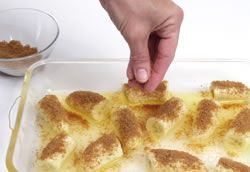 |
| Remove from the oven and place on small plates. Sprinkle with a small amount of coconut and lemon zest. Serve while warm. |
 |
Baked Plantains
The plantains can be prepared in several ways for baking. Some recipes may call for them to be peeled and left whole or the recipe may suggest cutting them into sections. They can also be left unpeeled and baked in their skins. Generally, if the plantains are peeled, there will be other ingredients added before they are baked. If baked in their skins, the recipe may call for other ingredients to be added after they are baked and peeled. The recipe below calls for the plantain to be baked in its skin so any additional ingredients will be added after it is cooked.
Fried Bananas
The bananas can be prepared in several ways for frying. First peel the skins and then cut or slice according to the recipe. The recipe used below is just one of many that can be used to fry bananas.
| Prepare 4 ripe bananas by peeling, cutting in half lengthwise and then cutting in half crosswise to form quartered sections. Do not use bananas that are overripe. |
 |
| In a small bowl, mix 1/4 cup of flour with 1 teaspoon of cinnamon. Stir until well blended. Coat banana sections with this mixture. |
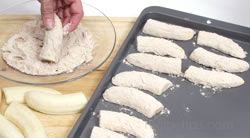 |
|
Heat 2 tablespoons of margarine in the bottom of a skillet over medium heat until sizzling.
Place the floured banana sections in the hot margarine and cook until browned on each side. Carefully turn once only. |

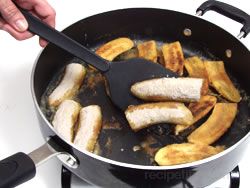
|
| Remove from the skillet when browned on each side and sprinkle with a little sugar. Serve while warm. |
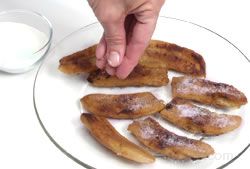 |
Deep-Fried Plantain
The plantains can be prepared in several ways for deep-frying. First peel the skins and then cut or slice according to the recipe. The recipe used below is commonly used for deep-frying plantains.
Dried Bananas
Drying removes the moisture from the bananas, leaving them with a concentrated flavor. Dried bananas make a sweet nutritious snack and are easy to store. They can also be reconstituted (see below) for use in sweet and savory dishes. The bananas that are to be dried should be all yellow with a few dark specs starting to appear but still firm. Do not use overripe bananas. There are several methods that can be used to dry bananas. Some of the common methods are sun-drying, oven drying, or drying in a dehydrator. The different methods are explained below.
|
Preparation:
Peel skin from bananas .
Slice bananas crosswise into rounds that are 1/4 to 3/8 inch thick. If preferred, the bananas can also be cut lengthwise into strips. |
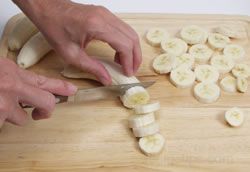
|
|
Pretreat bananas with lemon, lime or orange juice to help prevent them from turning brown.
The banana slices can also be pretreated with a acidulated water mixture, ascorbic acid solution, or honey dip to prevent them from turning brown. |
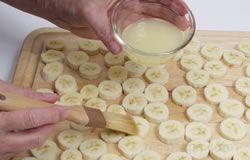 |
|
Sun Drying:
Place treated slices or strips in a single layer on a wire rack placed on a baking sheet. Do not allow banana pieces to be touching. Cover with cheesecloth and place in the sun in a well ventilated area.
Turn bananas every couple of hours. Bring bananas in at night. The drying process will take 2 to 3 days. This is not the preferred method for drying since it is slow and the drying process is hard to control. If the climate is humid it is advisable to not use this method of drying. |
|
Oven Drying:
Place prepared slices or strips in a single layer on a wire rack placed on a baking sheet. Do not allow banana sections to be touching. |

|
|
Place, uncovered, in an oven preheated between 125° to 150° F. Leave the oven door open a slight amount to allow air to circulate in the oven during the drying process. Dry for 8 to 12 hours, turning after six hours and checking for dryness after eight hours. If not dry, place them back in the oven for two more hours and check again.
Bananas can be dried until they are crisp or if preferred, they can be dried until they are just leathery in texture. Because of the length of time it takes to dry bananas in the oven, it can end up being one of the more expensive methods of drying. Keep this in mind when determining which drying method to use. |
|
Drying in Dehydrator:
Using a dehydrator is the most consistent method for drying.
Prepare in same manner as above. Place slices or strips on the trays of the dehydrator, being careful that the banana pieces do not touch. This allows more even air movement during drying time.
|
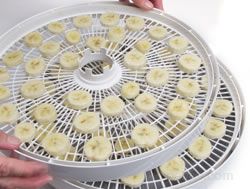
|
| Drying time for the bananas will be between 6 to 12 hours. Turn slices or strips over about half way through the drying time and alternate the positions of the dehydrator trays. The banana slices may stick slightly to the rack. If they do stick, use a table knife to gently loosen them while turning. |
 |
| Start checking to see if they are done after approximately 8 hours. If not at the desired dryness, allow to dry for another two hours. |
 |
| After the bananas have dried sufficiently, allow them to cool completely and then store in sealable plastic bags or covered plastic or glass containers. Store in the refrigerator or in a dark area where it is cool and dry. |
|
Reconstituting Dried Bananas |
|
Dried bananas can be reconstituted to use in some recipes.
- Place the dried bananas in a saucepan and pour enough boiling water over them to cover.
- Simmer for 10 to 15 minutes, until bananas have swollen and are tender.
- Drain and prepare as desired.
|
Tips
- One pound of bananas is equal to 3 or 4 medium whole bananas, 1 1/3 cup mashed, or 2 cups diced.
- Save overripe bananas for baking by peeling, mashing and placing in a freezer bag or airtight container. Place in the freezer and use when needed in breads, muffins, cakes, and other recipes that call for mashed bananas.
- Blend mashed bananas with ice cream to make a banana flavored shake.
- Place unripe bananas in a paper bag with one ripe apple to speed ripening.
- Place bananas that are the desired ripeness in the refrigerator to slow the ripening process. This will provide a few more days of use before they become overripe. The skins will turn brown but the flesh will not be affected. Keep up to 3 days in the refrigerator.
|

